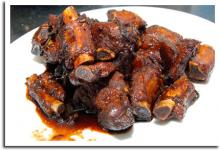
Luckily, the New Year is still a few weeks away. Although I had pledged earlier to stop buying cookbooks without mouth-watering photos, I think I am excused this once. Breaking a 2009 resolution in 2008 doesn’t count.
Anyways, the book that led me astray was How to Cook Everything by Mark Bittman. So far, I have tested a handful of recipes. I liked the Light and Fluffy Pancakes. The batter was denser than other recipes I have previously tried and did not spread out as much in the pan. The pancakes reminded me of a Japanese cake with red beans that I discovered at the 99 Ranch Market. The only downside was that the recipe called for whisking the egg whites until fairly stiff. I had a whisk and no electric mixer. Needless to say, my arm nearly fell off from the amount of whisking required.
I’ve also been on a quest as of late to make respectable pot stickers. After many attempts and different cookbooks, I think I’ve found a winner (ironically in a cookbook authored by a non-Chinese). The food critics at home all loved the pot sticker filling. This cookbook also provides directions on making Asian-Style Dumpling Wrappers. One of these weekends, I’ll attempt to produce some home made pot stickers wrappers, of course, with a package of store-bought wrappers as a back-up in case the recipe is not foolproof.

